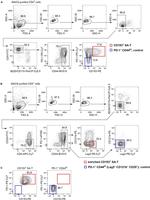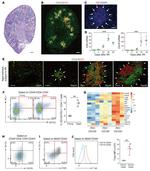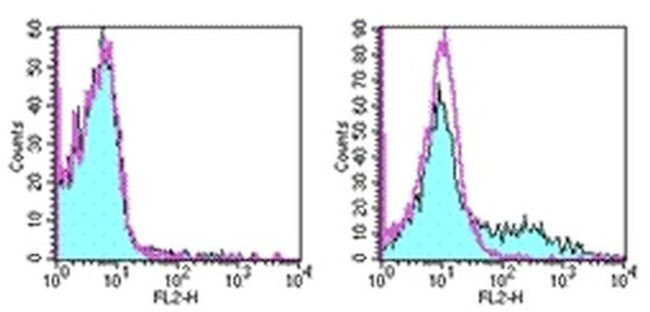Search Thermo Fisher Scientific
Invitrogen
CD153 Monoclonal Antibody (RM153), PE, eBioscience™
FIGURE: 1 / 3
CD153 Antibody (12-1531-82) in Flow



Product Details
12-1531-82
Species Reactivity
Published species
Host/Isotype
Recommended Isotype Control
Class
Type
Clone
Conjugate
Excitation/Emission Max
Form
Concentration
Purification
Storage buffer
Contains
Storage conditions
Shipping conditions
RRID
Product Specific Information
Description: The RM153 monoclonal antibody reacts with mouse CD153 (CD30 ligand). This 40 kDa cell surface receptor, a type II transmembrane protein, is a member of the TNF superfamily. Interaction of CD30 with CD153 plays an important role in T cell activation/costimulation. Expression of CD153 on T cells does not appear to require costimulation through CD28 and is upregulated via TCR engagement and peaks 24-48 hours after activation. Signaling through CD153 is important in costimulation of pre-activated T cells.
Applications Reported: The RM153 antibody has been reported for use in flow cytometric analysis.
Applications Tested: The RM153 antibody has been tested by flow cytometric analysis of activated mouse splenocytes. This can be used at less than or equal to 0.125 µg per test. A test is defined as the amount (µg) of antibody that will stain a cell sample in a final volume of 100 µL. Cell number should be determined empirically but can range from 10^5 to 10^8 cells/test. It is recommended that the antibody be carefully titrated for optimal performance in the assay of interest.
Excitation: 488-561 nm; Emission: 578 nm; Laser: Blue Laser, Green Laser, Yellow-Green Laser.
Filtration: 0.2 µm post-manufacturing filtered.
Target Information
The ligand for CD30 is CD30L (CD153). The binding of CD30 to CD30L mediates pleiotropic effects including cell proliferation, activation, differentiation, and apoptotic cell death. CD30 has a critical role in the pathophysiology of Hodgkin's disease and other CD30+ lymphomas. CD30 acts as a costimulatory molecule in thymic negative selection. In addition to its expression on Hodgkin's and Reed-Sternberg cells, CD30 is also found in some non-Hodgkin's lymphomas (including Burkitt's lymphomas), virus-infected T and B cells, and on normal T and B cells after activation. In T cells, CD30 expression is present on a subset of T cells that produce Th2-type cytokines and on CD4+/CD8+ thymocytes that coexpress CD45RO and the IL4 receptor.
For Research Use Only. Not for use in diagnostic procedures. Not for resale without express authorization.
How to use the Panel Builder
Watch the video to learn how to use the Invitrogen Flow Cytometry Panel Builder to build your next flow cytometry panel in 5 easy steps.
Bioinformatics
Protein Aliases: CD153; CD30 ligand; CD30-L; CD30ligand; Tumor necrosis factor ligand superfamily member 8
Gene Aliases: CD153; Cd30l; CD30LG; Tnfsf8
UniProt ID: (Mouse) P32972
Entrez Gene ID: (Mouse) 21949

Performance Guarantee
If an Invitrogen™ antibody doesn't perform as described on our website or datasheet,we'll replace the product at no cost to you, or provide you with a credit for a future purchase.*
Learn more
We're here to help
Get expert recommendations for common problems or connect directly with an on staff expert for technical assistance related to applications, equipment and general product use.
Contact tech support

